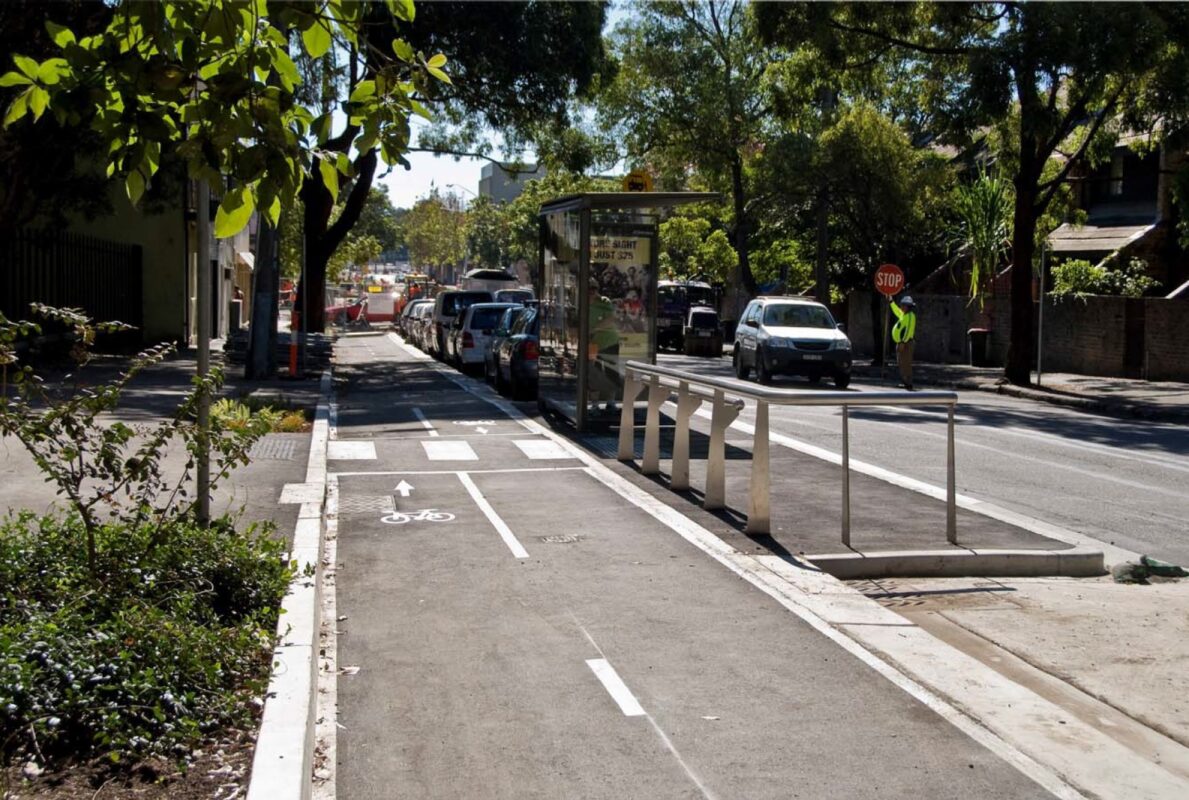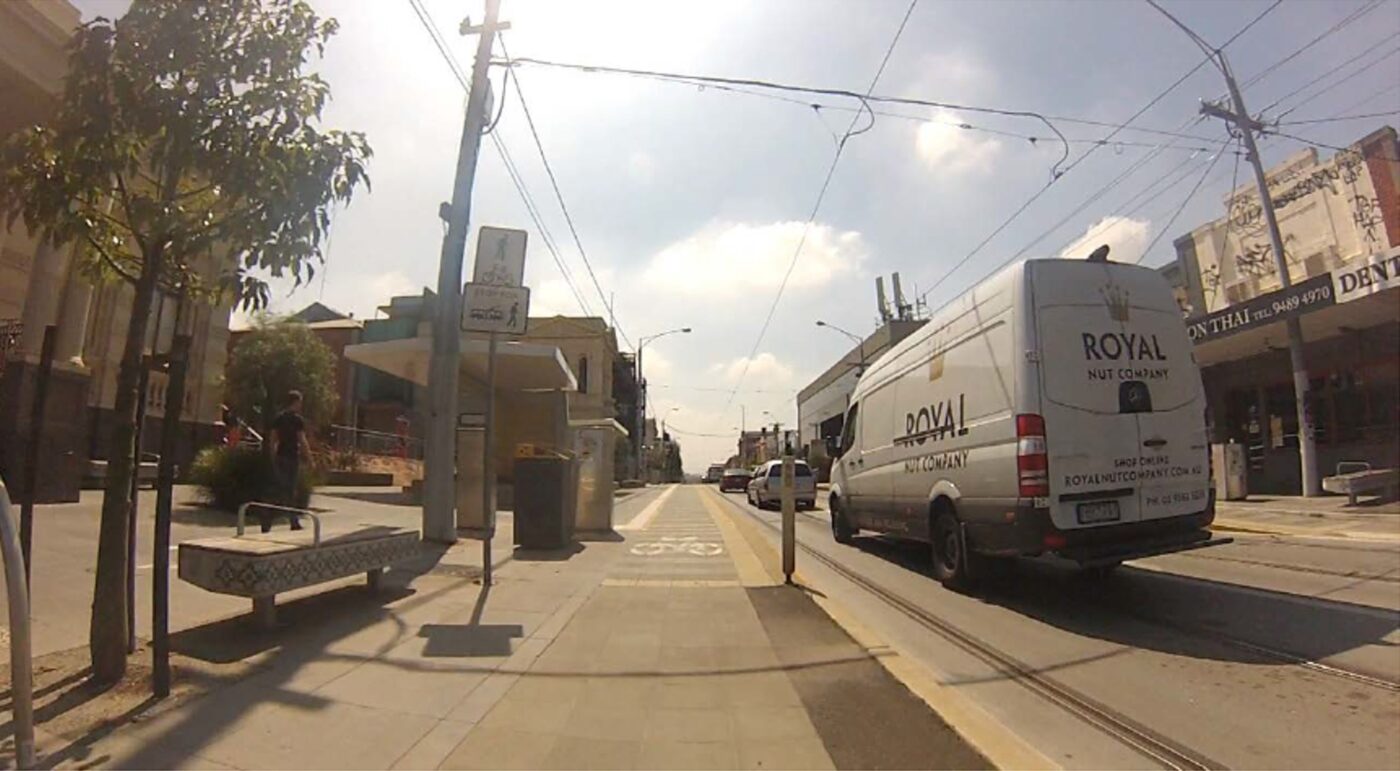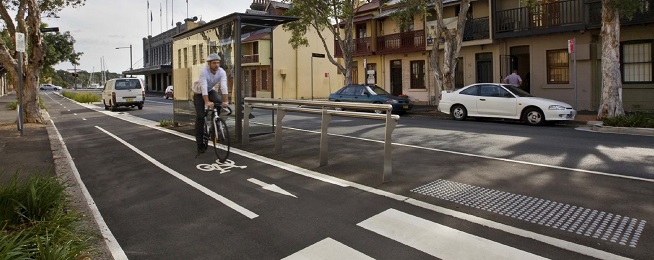Kingborough Council has deferred a decision on what their Kingston main street development will look like until more consultation is done on a design for a bus stop that would fit with a separated cycleway.
The Council was due to make a decision on Monday 21 March, with a staff report recommending against the construction of an uphill separated cycleway due to business concerns about loss of on-street car parking and community concerns about pedestrian safety around the bus stop.
An uphill separated cycleway would only mean the loss of four car parks in the overall redesign. We think rider safety should trump the loss of those parks, especially as the Kingston town centre has so much on-street and off-street car parking.
Concerns around the safety of people walking across the cycleway when getting on and off buses is a different kettle of fish. The last thing we want to see is cyclist safety being protected at the risk of other people’s safety.
Cyclists are at risk of being hit when buses pull in and out of stops, especially as bus blind spots are more extensive than cars and not all riders are aware of this. Some riders might position themselves where the driver can’t see them, contributing to the risk.
The national statistics show that historically around 1 in 4 deaths of people riding bicycles involve a heavy vehicle.
Floating bus stops
Street designers worldwide have generally adopted the floating bus stop design as the safest for people both riding and walking.

With this design the cycleway wends behind a bus stop, with passengers crossing the cycleway to get to the stop, which the bus pulls up alongside.
This means passengers getting off and on the bus are not at risk of anyone on bikes or scooters passing and hitting them. Instead, they follow the rail along the bus stop platform to cross at the designated crossing across the cycleway, marked as a zebra crossing.
This crossing can be raised so it’s level with the footpath and bus stop platform, and it becomes like a speed hump for people on bikes and scooters, which helps to slow them down.
The fact the cycleway bends around behind the bus stop also slows people on bikes and scooters, and in Kingston the bus stop is on the rise of the road so people on bikes at least are probably already slowing down.
Other places also narrow the cycleway to further slow riders, as happens in Adelaide on Frome Street and Geelong on Malop Street where the cycleway passes vehicle drop offs which are similar to bus stop setups.
The crossing would also have appropriate give way to pedestrian signs and could be painted or constructed of a different coloured surface to further delineate the crossing.
For people with vision impairment, tactile markers are installed on the ground surface to guide them and to further highlight to people on scooters and riders to slow down.
Bus shelters that are open sided or use clear glass are also preferred as they help people riding see people who may be about to cross over the cycleway.
Sydney has been using this design and haven’t reported any problems, even in very busy areas like Bondi. It’s also a design that has been used for many years in Europe, especially The Netherlands and the United Kingdom.
The benefit for riders with this design is that they don’t have to stop when a bus is pulled in, although they would be required to give way to people crossing the cycleway.
Tram-stop style bus stops
The original bus stop design option put forward was tram-stop style arrangement where the cycleway is positioned between the bus shelter and where the bus stops.

This would mimic the situation in Swanston Street in Melbourne where stop signs for cyclists are triggered when the tram doors are open – cyclists must stop and wait for passengers to get on and off and the doors to close before they can pass a tram.
Vancouver is a city where floating bus stop and tram-stop style bus stops are both used, depending on the space available.
Melbourne has not had problems with conflict between passengers and riders. There is greater awareness in Melbourne of stopping to allow tram passengers on and off, so it would require a dedicated education campaign in Kingston.
Some of the safety design features used for the floating stop crossing can be used here to slow riders and alert them to the need to stop: raised platform crossings, surface markings, tactile markers, signage and some sort of automated stop sign.
The disadvantage for riders is that they have to stop for longer to wait for passenger to get on and off.
Transform Kingston project
The cycleway on the Channel Highway is being proposed as part of the Transform Kingston project that has been funded by the Hobart City Deal.
Under the City Deal funding, which is provided by federal and state governments with some input from local councils, Kingborough Council had $7 million to spend on implementing the Kingston Place Strategy to complement the investment in bus park and rides and moving one of the Channel Highway bus stops off the street.
Under this strategy the main two blocks of Channel Highway through the town centre would be transformed into Kingston’s main street. To do this the strategy recommends investing in making the area more “walkable”:
“The objective of this investment is to promote walking and cycling to and within the Town Centre and boost public transport patronage.”
We know that the majority of the population want to ride more but don’t because they are concerned about traffic. Most people want to see riding separated from car traffic and parked cars because of the safety risk for people riding, especially younger riders and people who are less experienced or confident about riding.
It’s clear that a street with the high volume of vehicles that Channel Highway has is much better off separating people riding from vehicle interactions as much as possible. Doing so will make more people confident to ride into and through the town centre.
It will also provide an instantly legible link for the other planned bike paths in the council’s long-term bike plan, which was approved recently.
Thanks to City of Sydney for photos of floating bus stops.


